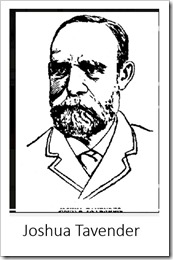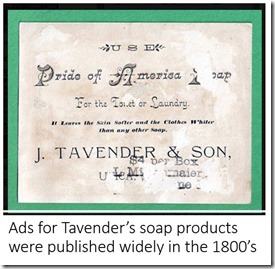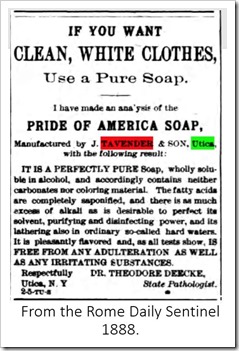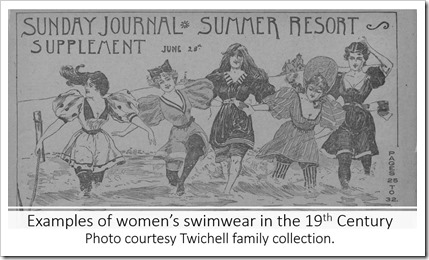From its inception, the Westminster Park Community was spurred along by the astute cultivation of a relationship with the media. In the 1870’s and the 1880’s, “media” meant connections in the newspaper and the publishing worlds. Early lot owners included Augustus C. Kessinger (lot 761), founder of the “Rome Daily Sentinel”. Patrick Agan, a well-known publisher from Syracuse, served a term on the Westminster Park Board of Trustees. J. G. Truair of the “Syracuse Journal” visited the Park and published pamphlets for the Park Hotel.
|

Map of Westminster Park of the Thousand Islands by Frank Hinds 1878
Photo courtesy Twichell family collection
|
Often, we see articles shared between one newspaper and another in Upstate cities. For example, an article from the “Utica Herald” might appear verbatim a day or two later in the “Watertown Daily Times”.
The Park Trustees spread the word of the newly emerging Westminster Community across New York State. The latest developments in the Park constructions and the names of prominent visitors were often found in the social news columns in Upstate newspapers. The Park selected certain designated reporters from city newspapers to visit the Hotel and return with articles to their respective papers. One such reporter was John J. Flanagan of Utica. We remember this gentleman from last month as the first President of the Saint Lawrence River Anglers’ Association. He was a jolly and energetic newspaper man who began his career as a telegraph expert and news reporter. When he died at age 47, he was editor of the “Utica Herald”. His newsy reports from the Saint Lawrence River were often signed J. J. F. with the byline,” From our own Correspondent.”
 One such report from the “Utica Morning Herald Daily Gazette” in September 1881 was a delight to read. Flanagan’s enthusiasm for the River is contagious. His report begins at the Crossmon House in Alexandria Bay listing all the “notables” staying there, including Henry S. Harper of “Harper’s Magazine”. (Many collectors of River memorabilia have a copy of an 1881 article published in “Harper’s New Monthly Magazine” entitled, “Summering Among the Thousand Islands”.)
One such report from the “Utica Morning Herald Daily Gazette” in September 1881 was a delight to read. Flanagan’s enthusiasm for the River is contagious. His report begins at the Crossmon House in Alexandria Bay listing all the “notables” staying there, including Henry S. Harper of “Harper’s Magazine”. (Many collectors of River memorabilia have a copy of an 1881 article published in “Harper’s New Monthly Magazine” entitled, “Summering Among the Thousand Islands”.)
Flanagan goes on to describe the September scene on the River as businessmen pack up to leave for the season. The weather was glorious. The autumn air was laden with ozone…”fairly bubbling in the atmosphere like champagne…” His comments on women’s hairstyles are hilarious. He regales readers with tales of River Notables and their beautiful island homes, and then says a few words about Westminster Park: “Mrs. Northrup, V. B. Stewart, Mr. Tavender, Dr. Gallup, and other Utica and country people on Westminster Park — all as enthusiastic and eager for drinking in the air and beauty of this region as they were on the first day of their coming here. Every day that the sun shines upon the River and Thousand Islands develops richness, freshness, and loveliness that can be found in no other part of America.”
Previous articles in thousandislandslife.com told about the Northrup family and the Stewart families. This month we will tell the story of yet another prominent Utica businessman who attended the WP Lot Sale of 1878. Joshua Tavender was a friend of Devillo Washington Northrup and William Penn Carpenter. Tavender purchased Lot 656 on the first day of the sale. An overview of his life story reveals many connections pertinent to the history of Westminster Park, the Saint Lawrence River, and Upstate New York.
Joshua Tavender (1822- 1895) married Harriet Maynard (1819- 1895) in Somerset, England in 1849. Shortly after their marriage, Mr. and Mrs. Tavender emigrated to Utica, New York, to join Harriet’s brother, Isaac Maynard, and Harriet’s brother-in-law, John Thorn, who were established in business ventures there. This familial relationship has an impact on the history of transportation in New York State and on the development of our story.
When Mr. Tavender first arrived in Utica, he found employment with Thorn and Maynard Soap and Candle company. Later he formed a partnership in a similar business with William Heath. In time, Tavender bought out Mr. Heath and formed a company with his own son, Walter. Their new partnership was known as Joshua Tavender and Son. A featured product was their “Pride of America Soap” which sold in 1893 for seven bars for 23 cents. Other products included fertilizers, chemicals, oils, candle and glues. Mr. Tavender had a reputation for honesty, integrity, and hard work.
 The Tavenders were deeply religious and charitable people. Joshua was aligned with the Bible Study Movement. He was a close friend to Charles Taze Russell, author of the Millennial Dawn and founder of Zion’s Watch Tower newsletter. C. T. Russell and Joshua Tavender believed in “the plan of the ages”, i.e., the signs of the times indicating the Bible prophecies. In Utica, he attended the Tabernacle Baptist Church, espoused the credo of the Golden Rule, taught Sunday School at the Faxton Hall Sunday School, and was a strong proponent of Prohibition. In 1894 while crossing railroad tracks in his horse-drawn carriage, Mr. Tavender was thrown from his wagon and hit his head. He suffered what was likely a concussion. He continued to have headaches and dizziness until his death a year later.
The Tavenders were deeply religious and charitable people. Joshua was aligned with the Bible Study Movement. He was a close friend to Charles Taze Russell, author of the Millennial Dawn and founder of Zion’s Watch Tower newsletter. C. T. Russell and Joshua Tavender believed in “the plan of the ages”, i.e., the signs of the times indicating the Bible prophecies. In Utica, he attended the Tabernacle Baptist Church, espoused the credo of the Golden Rule, taught Sunday School at the Faxton Hall Sunday School, and was a strong proponent of Prohibition. In 1894 while crossing railroad tracks in his horse-drawn carriage, Mr. Tavender was thrown from his wagon and hit his head. He suffered what was likely a concussion. He continued to have headaches and dizziness until his death a year later.
Mrs. Tavender devoted her life to helping the poor, and also the families of soldiers who were fighting in the Civil War. She was a charter member of the Women’s Christian Association. (founded by Rev. P. H. Fowler’s wife, Jennette Fowler). Harriet attended the Highland Presbyterian Church in Utica. She founded a Sunday School in her own home, and as it became popular and grew in size, she moved the meetings to Faxton Hall. (Faxton Hall was established by Theodore S. Faxton, a Utica philanthropist who had established the Faxton Hall for the purpose of providing “the education of the children of factory operatives by day and night”.)
The Tavender’s had one son, Walter, business partner of his father. Walter began his career in the Tavender Soap Company in Utica and continued to work in the soap industry until his death in in 1938. After his father’s death in 1895, he moved to Boston, Massachusetts, working for the City of Boston. He was credited with developing a product which removed grease from public sewers and a number of other chemical products. Walter’s career kept him away from Westminster Park.
Joshua and Harriet Tavender also had three daughters, Harriet (known as Hattie), Sophia, and Jennie. These young ladies were River girls. Accounts of their lives in Utica and in Westminster Park show their enjoyment of the River and an active social life.
The Tavender cottage appears to have been built by 1881. As young women, all three sisters spent time there, along with their River Cousins from the Peckham family, the Chase family, and the Maynard family.
One account from the papers tells of a boating accident in the summer of 1881. One August afternoon, the Tavender girls and a group of friends were cruising from Westminster Park on a beautiful steam yacht, the Ooneta. Off Thousand Island Park, there suddenly came a loud crash, filling the occupants with terror. The boat sustained damage to her wheel by running-up on a shoal and was disabled. The distress signal was given and the yacht, Flora, of Fishers Landing came to the rescue. All were towed to the Wellesley House and safety.
Records from the summer of 1883 show that Hattie, Jennie, Joshua, and Walter’s wife were at the cottage for the entire season. In August of 1883, Sophie records an afternoon of swimming! In those days of personal modesty, I wonder how one could swim in yards of fabric prescribed for ladies’ swimsuits.
 In early 1881, Jennie married Dennis T. Kelly of Watertown, NY. He was a senior proprietor of the “Dispatch and Reunion”. The newlyweds honeymooned in Albany, New York. In the early days of their marriage, they roomed at the Paddock House in Watertown. The Kelly’s moved about New York State, living in Buffalo, New York City, and Utica. Dennis Kelly also worked as Secretary of McMahon Thermograph Company. Jennie continued to visit Westminster family members. The Kelly’s had one son.
In early 1881, Jennie married Dennis T. Kelly of Watertown, NY. He was a senior proprietor of the “Dispatch and Reunion”. The newlyweds honeymooned in Albany, New York. In the early days of their marriage, they roomed at the Paddock House in Watertown. The Kelly’s moved about New York State, living in Buffalo, New York City, and Utica. Dennis Kelly also worked as Secretary of McMahon Thermograph Company. Jennie continued to visit Westminster family members. The Kelly’s had one son.
In 1889, Jennie developed an illness that was not believed to be serious, but sadly, she died in February of 1890 at the age of 33. One obituary remembers her as being congenial with fine social qualities.
Sophia was especially close to her cousin, Julia Josephine Maynard Griffith. (The life of Mrs. Griffith will be told in future installment.) Sophie and Josephine were often together at social events. In 1895 following the death of both of Sophia’s parents, they spent the Lenten Season together in Washington, DC. In 1898, Sophia Tavender married Charles G. Karling, of Illion, New York. The wedding was held at the home of Mr. and Mrs. George U. Maynard of Utica. The wedding was a simple family affair presided over by Rev. Dr. Burnham of Colgate University. The parlors were decorated with palms, ferns, roses, carnations, and other flowers. The groom held a position in a typewriter firm. The couple resided in Illion, New York.
Harriet (Hattie) also married after the death of her parents. Her wedding to Milo Oglin Town of Richfield, New York, was held at the home of her cousin Josephine, who by now was also married and living in the home formerly owned by her parents, The Maynards. It was a small, intimate gathering presided over by Rev. Walter Mitchell of the Utica Highland Presbyterian Church. Hattie was described as having “an artistic temperament”. The couple honeymooned in Niagara Falls and set up housekeeping in Richfield, New York, where Milo was a merchant.
The Tavender family enjoyed life in Westminster Park for the first quarter century of the Park’s history. Their cousin, Josephine, stayed for another two decades. And so, it goes when the River calls to you.
Next month’s installment: the Gallup and the Goss Family
©Linda Twichell 2018
Linda Lewis Twichell, a fifty-six-year resident of Westminster Park, has collected historical information on the Westminster community since the 1970’s. Presently, her research focuses on the lives of the people who settled here in the last quarter of the 19th century, and the cottages they built. A book of Westminster Park, its people, and their stories is in the works. Be sure to check out Linda’s other historical research published in previous issues of TI Life.